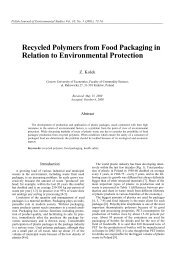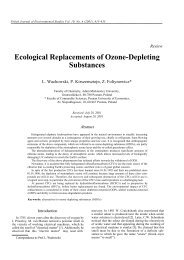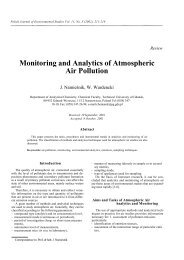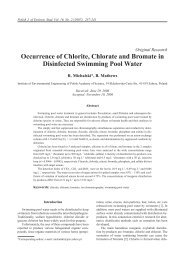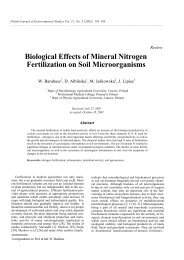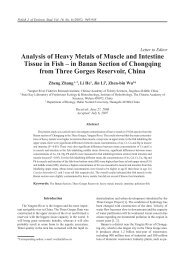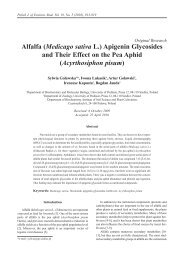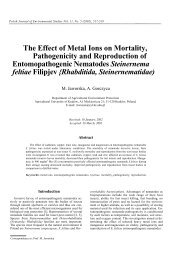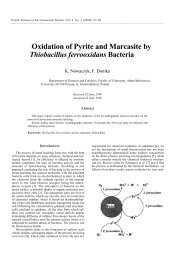Water Fungi and Fungus-like Organisms Isolated from Surface ...
Water Fungi and Fungus-like Organisms Isolated from Surface ...
Water Fungi and Fungus-like Organisms Isolated from Surface ...
Create successful ePaper yourself
Turn your PDF publications into a flip-book with our unique Google optimized e-Paper software.
Polish J. Environ. Stud. Vol. 15, No. 2 (2006), 277-281<br />
Original Research<br />
<strong>Water</strong> <strong>Fungi</strong> <strong>and</strong> <strong>Fungus</strong>-<strong>like</strong> <strong>Organisms</strong> <strong>Isolated</strong><br />
<strong>from</strong> <strong>Surface</strong> <strong>Water</strong>s Situated in the Białowieża<br />
Primeval Forest Using the Liver Fluke Fasciola<br />
Hepatica L. of European Bison Bonasus L. as Bait<br />
B. Kiziewicz<br />
Department of General Biology, Medical University of Białystok, 15-089 Białystok, Kilińskiego 1, Pol<strong>and</strong><br />
Received: November 8, 2004<br />
Accepted: July 19, 2005<br />
Abstract<br />
<strong>Water</strong> fungi <strong>and</strong> fungus-<strong>like</strong> organisms as a biological factor of ecological water systems have significant<br />
influence on the environment <strong>and</strong> its modification. They decompose necrosis substrates found in water<br />
bodies. <strong>Fungi</strong> also can act as facultative parasites <strong>and</strong> then frequently occur on their hosts. The main aim of<br />
the present study is to investigate which of the fungi <strong>and</strong> straminipiles can grow on the liver fluke Fasciola<br />
hepatica in the River Narewka <strong>and</strong> in natural ponds of Białowieża village.<br />
In order to isolate fungi <strong>and</strong> fungus-<strong>like</strong> organisms, fragments of adults <strong>and</strong> eggs <strong>from</strong> liver flukes were<br />
introduced as bait into samples <strong>from</strong> each water body. The occurrence <strong>and</strong> growth of aquatic fungi <strong>and</strong><br />
fungus-<strong>like</strong> organisms on Fasciola hepatica was investigated in laboratory conditions.<br />
The liver fluke F. hepatica used in this study was collected <strong>from</strong> free-living European bisons, Bison<br />
bonasus, which were killed in Białowieża Primeval Forest.<br />
The adult liver fluke F. hepatica turned into the habitat for seventeen species of fungi <strong>and</strong> straminipiles. They<br />
were Achlya poly<strong>and</strong>ra, A. prolifera, Apodachlya brachynema, Aphanomyces laevis, Ap. irregularis, Catenaria<br />
anguillulae, Dictyuchus monosporus, Leptolegnia caudata, Leptomitus lacteus, Pythium debaryanum, Sirolpidium<br />
zoophtorum, Saprolegnia diclina, S. glomerata, S. hypogyna, S. monoica, S. ferax <strong>and</strong> S. parasitica.<br />
Six fungal species such as Achlya prolifera, Aphanomyces irregularis, Myzocytium zoophthorum, Catenaria<br />
anguillulae, Saprolegnia ferax <strong>and</strong> S. parasitica were found on F. hepatica eggs.<br />
The majority of fungi which were marked on F. hepatica were animal parasites or necrotrophs (13).<br />
Keywords: fungi, Straminipila, liver fluke Fasciola hepatica, bison European Bison bonasus, the River<br />
Narewka, natural ponds of Białowieża village, Białowieża Primeval Forest, physical <strong>and</strong> chemical analysis<br />
*e-mail: bkizbiol@amb.edu.pl<br />
Introduction<br />
<strong>Water</strong> fungi <strong>and</strong> fungus-<strong>like</strong> organisms as biological<br />
factors of ecological water systems influence the<br />
environment significantly. They decompose together<br />
with bacteria necrosis substrates occuring in water<br />
bodies. Moreover, they can optionally act as parasites,<br />
too. Animal parasites constitute a large group <strong>and</strong> are<br />
often found on invertebrates <strong>and</strong> vertebrates [1, 2, 3].<br />
The liver fluke Fasciola hepatica occurs in the common<br />
bile ducts of mammal hosts such as wild <strong>and</strong><br />
farm black rats, ostriches, sheep, cattle, pigs, donkeys,<br />
hares, bisons <strong>and</strong> humans [4, 5, 6, 7]. Adult liver flukes<br />
which live in bile ducts, produce eggs which are passed<br />
in faeces. When the eggs separate <strong>from</strong> faecal mate-
278<br />
rial in wet areas, under optimal conditions they will<br />
hatch, releasing the larvae or miracidia. The miracidia<br />
invade the lymnaeid snails in which they develop <strong>and</strong><br />
multiply as sporocyst, rediae <strong>and</strong> cercariae. The tadpole-<strong>like</strong><br />
cercariae leave the snails <strong>and</strong> swim until they<br />
locate on water plants <strong>and</strong> form metacercariae, which<br />
are the mammal-infective stage of the fluke. If ingested<br />
by hosts, including humans, the metacercariae settle in<br />
the small intestine <strong>and</strong> the released immature flukes<br />
penetrate the intestinal wall <strong>and</strong> enter the abdominal<br />
cavity. The young flukes penetrate the liver capsule <strong>and</strong><br />
migrate through the liver tissue for 6 to 7 weeks before<br />
entering the bile ducts prior to becoming adult flukes.<br />
The flukes reach sexual maturity <strong>and</strong> commence egg<br />
production [8].<br />
The main aim of the present study was to determine<br />
species composition of the fungi <strong>and</strong> fungus-<strong>like</strong> organisms<br />
growing on the liver fluke F. hepatica in the River<br />
Narewka <strong>and</strong> in natural ponds situated in Bałowieża village<br />
of Białowieża Primeval Forest in the years 2002-<br />
03 as well as the effect of ecological factors, including<br />
certain physical <strong>and</strong> chemical parameters of water <strong>and</strong><br />
composition of the substratum <strong>from</strong> which the fungi were<br />
isolated.<br />
Materials <strong>and</strong> Methods<br />
The water samples were collected <strong>from</strong> the following<br />
water reservoirs: Narewka River <strong>and</strong> natural ponds of<br />
Białowieża village of Białowieża Primeval Forest.<br />
1. The Narewka River on the Polish side is 39.4 kilometers<br />
long. The upper stretch of the river flows across<br />
the area of Białowieża Primeval Forest. The samples<br />
were collected in the upper course of the river near<br />
Białowieża village.<br />
2. Natural ponds in Białowieża village, an area of 2 hectares,<br />
are sites of crucian carps being bred for fishing.<br />
The ponds in Białowieża village are natural bodies<br />
supplied by water <strong>from</strong> the Narewka. They are overgrown<br />
by plants.<br />
The liver fluke F. hepatica used in this study was<br />
collected <strong>from</strong> free-living European Bison bonasus L.,<br />
<strong>from</strong> Białowieża Primeval Forest which were killed<br />
during natural selection. Nowadays, the population of<br />
wild European Bison bonasus in the Białowieża Primeval<br />
Forest on the Polish side consists of up to 349<br />
individuals <strong>and</strong> on the Belarusian side of about 275 individuals<br />
in 2002 [9].<br />
The bait method using adults <strong>and</strong> egg liver fluke<br />
F. hepatica was applied to isolate fungi [10]. The<br />
liver fluke isolates were placed in one-liter containers<br />
with water samples collected <strong>from</strong> the respective<br />
sites. The containers were covered with glass plates,<br />
at least partly to protect the water <strong>from</strong> penetration by<br />
bacteria. The samples were stored for approximately<br />
one month in a laboratory at the same temperature as<br />
that measured in the respective water reservoir, river<br />
Kiziewicz B.<br />
Table 1. Physical <strong>and</strong> chemical parameters of water <strong>from</strong> the<br />
different sites (mean <strong>from</strong> 6 samples).<br />
Specification<br />
River<br />
Narewka<br />
or pond. Light <strong>and</strong> temperature were regulated to resemble<br />
natural thermal <strong>and</strong> light conditions [11]. Microscopically<br />
determined mycelia were removed <strong>from</strong><br />
the baits <strong>and</strong> transferred to sterilized Petry plates containing<br />
distilled water. The microscopic examination<br />
of the mycelia was repeated after a few days. Several<br />
microscopic preparations were carried out each time.<br />
Identification of the aquatic fungi <strong>and</strong> fungus-<strong>like</strong> organisms<br />
involved measurements <strong>and</strong> determination of<br />
the vegetative organs – shape <strong>and</strong> size of the hyphae,<br />
asexual reproductive organs – shape of sporangium<br />
<strong>and</strong> spores, <strong>and</strong> generative organs – the structure of<br />
the oogonium, oosporangium <strong>and</strong> antheridium. <strong>Fungi</strong><br />
were identified according to the works of Batko [10],<br />
Dick [12] <strong>and</strong> Pystina [13]. The results were subjected<br />
to statistical analysis using t-test to determine<br />
the significance of differences in the number of fungi<br />
<strong>and</strong> fungus-<strong>like</strong> organisms on eggs <strong>and</strong> on adult liver<br />
flukes in particular sites of water.<br />
Physical <strong>and</strong> chemical investigations were performed<br />
using commonly applied hydro- biological methods [14].<br />
Results<br />
<strong>Water</strong> bodies<br />
Ponds<br />
Białowieża village<br />
Temperature ( o C) 8.4 12.5<br />
pH 7.2 7.9<br />
Oxidability (mg l -1 ) 15.4 12.6<br />
N-NH 4<br />
(mg l -1 ) 0.610 0.450<br />
N-NO 2<br />
(mg l -1 ) 0.014 0.010<br />
N-NO 3<br />
(mg l -1 ) 0.17 0.22<br />
P-PO 4<br />
(mg l -1 ) 0.83 0.40<br />
As revealed by physical <strong>and</strong> chemical analysis of the<br />
River Narewka <strong>and</strong> ponds of Białowieża village collected<br />
<strong>from</strong> particular sites in 2002 <strong>and</strong> 2003, the water at<br />
the site on the Narewka had the highest number of biogenes<br />
(N-NH 4<br />
, P-PO 4<br />
) <strong>and</strong> oxidability. In natural ponds<br />
of Białowieża village the highest level of nitrate nitrogen<br />
was marked (Table 1).<br />
Eighteen fungi <strong>and</strong> fungus-<strong>like</strong> organisms were isolated<br />
<strong>from</strong> adult liver flukes. Only five species of fungus<br />
were marked on F. hepatica eggs. The greatest number<br />
of fungi was found on adults (17), the lowest number<br />
on eggs of liver flukes (6). The results obtained may be<br />
important to parasitologists, because 18 of the recorded<br />
fungi are known as necrotrophs or animal parasites<br />
(Table 2, Fig. 1).
<strong>Water</strong> <strong>Fungi</strong> <strong>and</strong> <strong>Fungus</strong>-<strong>like</strong> <strong>Organisms</strong>... 279<br />
Table 2. <strong>Fungi</strong> <strong>and</strong> fungus-<strong>like</strong> organisms found on eggs (1) <strong>and</strong> adults (2) of liver fluke Fasciola hepatica in particular sites of the River<br />
Narewka <strong>and</strong> of ponds in Białowieża village.<br />
Straminipila<br />
Peronosporomycetes<br />
Leptomitales<br />
Taxa<br />
River<br />
Narewka<br />
(1)<br />
*<strong>Fungi</strong> known in literature as parasites or necrotrophs of animals<br />
River<br />
Narewka<br />
(2)<br />
Site<br />
Ponds<br />
Białowieża village<br />
(1)<br />
Ponds<br />
Białowieża village<br />
(2)<br />
Apodachlya brachynema (Hildebr.) Pringsh. x x<br />
*Leptomitus lacteus (Roth) Agardh<br />
Pythiales<br />
*Myzocytium zoophthorum Sparrow x x<br />
Pythium debaryanum R. Hesse x x<br />
*Sirolpidium zoophthorum Vishniac<br />
Saprolegniales<br />
*Achlya poly<strong>and</strong>ra Hildebr.<br />
*A. prolifera Nees. x x<br />
Aphanomyces irregularis W.W. Scott x x x<br />
*Ap. laevis de Bary x x<br />
*Dictyuchus monosporus Leitg. x x<br />
*Leptolegnia caudata de Bary<br />
*Saprolegnia diclina Humphrey x x<br />
S. glomerata (Tiesenhausen) Lund x<br />
*S. ferax (Gruith.) Thur. x x x x<br />
*S. hypogyna (Pringhs.) de Bary x x<br />
*S. monoica Pringsh.<br />
*S. parasitica Coker x x x x<br />
FUNGI<br />
Chytridiomycetes<br />
Blastocladiales<br />
Catenaria anguillulae Sorokin x x x<br />
Total number 6 11 5 14<br />
x<br />
x<br />
x<br />
x<br />
x<br />
There was not any difference between the number of<br />
fungi <strong>and</strong> straminipiles which were marked on eggs <strong>and</strong><br />
adult liver flukes <strong>and</strong> particular sites of water during the<br />
study.<br />
Discussion<br />
Eighteen fungus species were collected during this experiment.<br />
The genera, namely Saprolegnia ferax <strong>and</strong> S.<br />
parasitica, were of high frequency of occurrence on eggs<br />
<strong>and</strong> adult liver flukes in the River Narewka <strong>and</strong> in ponds<br />
of Białowieża village.<br />
Representatives of the class Peronosporomycetes<br />
were the most numerous group of fungus-<strong>like</strong> organisms<br />
found on liver flukes.<br />
The eggs <strong>and</strong> fragments of adults liver flukes examined<br />
were inhabited by a number of fungus-<strong>like</strong> organism<br />
species which frequently cause significant losses in fish<br />
farming, including Achlya poly<strong>and</strong>ra, A. prolifera, Apha-
280<br />
nomyces irregularis, A. laevis, Leptolegnia caudata, Saprolegnia<br />
diclina, S. ferax, S. hypogyna, S. monoica <strong>and</strong> S.<br />
parasitica. These straminipiles are commonly encountered<br />
both on dead vegetation <strong>and</strong> animal material. However, in<br />
favourable conditions they parasitize on weakened <strong>and</strong><br />
mechanically damaged animals, mainly spawn <strong>and</strong> fish in<br />
their different developmental periods [15, 16, 17].<br />
Aphanomyces laevis attacks both eggs <strong>and</strong> adult individuals<br />
of many economically valuable fish species [18].<br />
In our study Pythium debaryanum found on eggs of Fasciola<br />
hepatica was isolated <strong>from</strong> the River Narewka <strong>and</strong><br />
<strong>from</strong> ponds of Białowieża village. Pythium debaryanum<br />
has been known since the middle of the previous century<br />
as phytopatogenic fungus-<strong>like</strong> organism <strong>and</strong> has been encountered<br />
in various water reservoirs [13, 19].<br />
Interestingly, the fungus-<strong>like</strong> organisms Leptolegnia<br />
caudata on Fasciola hepatica were found in the ponds<br />
of Białowieża village. This species was encountered as a<br />
parasite of predatory crustaceans Leptodora kindtii [10].<br />
Leptolegnia caudata was observed to be an aquatic <strong>and</strong><br />
soil saprotroph found on crustaceans, dragonflies, snake<br />
skin <strong>and</strong> spawn of various fish species [18, 20, 21].<br />
A nitrophilic fungus-<strong>like</strong> organism, Leptomitus lacteus,<br />
commonly found in sewage, was isolated only once<br />
on an adult liver fluke in the ponds of Białowieża village.<br />
This taxon allows detection of the inflow of industrial<br />
effluents <strong>and</strong> was investigated by Staniak [22]. Leptomitus<br />
lacteus is a parasite <strong>and</strong> necrotroph fungus which<br />
was marked <strong>from</strong> the spawn of certain fish [17, 23] <strong>and</strong><br />
<strong>from</strong> perch [24]. Two species, Myzocytium zoophthorum<br />
<strong>and</strong> Sirolpidium zoophthorum, were isolated on eggs <strong>and</strong><br />
adult liver flukes <strong>from</strong> the River Narewka <strong>and</strong> ponds of<br />
Białowieża village. These fungus-<strong>like</strong> organisms are described<br />
as parasites of rotifers <strong>and</strong> larvae of mollusces,<br />
while Myzocytium megastomum was found on aquatic<br />
insects in lakes <strong>and</strong> ponds in Pol<strong>and</strong> by Czeczuga <strong>and</strong> Godlewska<br />
[25]. It was described by Batko [10] as a parasite<br />
of algae.<br />
Of the Chytridiomyces class isolated in the study, Catenaria<br />
anguillulae, which was found in the River Narewka<br />
<strong>and</strong> in ponds of Białowieża village on eggs Fasciola<br />
hepatica, was the most frequently encountered fungus.<br />
This fungus, known as a phytosaprotroph <strong>and</strong> zoosaprotroph,<br />
was previously isolated <strong>from</strong> chitin <strong>and</strong> keratincontaining<br />
substrates [26-30].<br />
Fig. 1. Dictyuchus monosporus -sporangium growing on the<br />
liver fluke Fasciola hepatica.<br />
Kiziewicz B.<br />
The majority of species of fungi which were marked<br />
on Fasciola hepatica are animal parasites or necrotrophs<br />
[1, 10, 31].<br />
In conclusion, the liver fluke Fasciola hepatica is connected<br />
with an aquatic water environment, in which part<br />
of its development is spent, i.e. egg development, miracidium<br />
stage, intramoluscal stage, cercaria <strong>and</strong> metacercariae.<br />
In this stage fungi participate in food-competition<br />
which as decomposers, parasites <strong>and</strong> predators can play a<br />
part in stopping parasite development. Particularly mycosis<br />
infection can occur on eggs <strong>and</strong> larvae stages of Fasciola<br />
hepatica in water such as: miracidia, cercariae <strong>and</strong><br />
metacercariae, which is probably why the flukes do not<br />
always reach sexual maturity in their definitive hosts.<br />
The fungi which were marked on eggs of the liver fluke<br />
Fasciola hepatica can lead to stopping the development of<br />
the parasite in aquatic water environment. They can contribute<br />
to the elimination of Fasciola hepatica at an initial<br />
stage of its development. This study on fungus growth on<br />
parasites is an important element to broaden knowledge on<br />
mycology, epidemiology <strong>and</strong> parasitology.<br />
Acknowledgements<br />
The author is grateful to Prof. dr. hab. Małgorzata<br />
Krasińska of the Mammal Research Institute PAS <strong>and</strong> Dr.<br />
Zbigniew A. Krasiński of Białowieża National Park for<br />
their help in obtaining the liver fluke Fasciola hepatica<br />
<strong>from</strong> bisons European Bison bonasus.<br />
References<br />
1. DICK M.W. The Peronosporomycetes. The Mycota VII.<br />
Part II. Systematics <strong>and</strong> evolution. Mc Lauglin/Mc Lauglin<br />
/Lemke (Eds.). Springer-Verlag-Berlin-Heidelberg, pp. 72,<br />
2001.<br />
2. HUSSEIN M.M., HATAI, K., NOMURA T. Saprolegniosis<br />
in salmonids <strong>and</strong> their eggs in Japan. J. Wild. Dis., 37, 204,<br />
2001.<br />
3. CZECZUGA B., KIZIEWICZ B., GODLEWSKA A. Zoosporic<br />
fungi growing on Leeches (Hirudinea). Pol. J. Envir.<br />
Stud., 12, 361, 2003.<br />
4. MAS-COMA S., FONS R., FELIU C., BARGUES M.D.,<br />
VALERO M.A. GALÁN-PUCHADES M.T. Small mammals<br />
as natural definitive hosts of the liver fluke, Fasciola<br />
hepatica Linnaeus, 1758 (Trematoda: Fasciolidae): A review<br />
<strong>and</strong> two new records of epidemiologic interest on the<br />
Isl<strong>and</strong> of Corsica. Rev. Parasitol., 5, 73, 1998.<br />
5. DRÓŻDŻ J., DEMIASZKIEWICZ A.W., LACHOWICZ J.<br />
Helmintofauna żubrów Bison bonasus (L.) żyjących na swobodzie<br />
w Bieszczadach (Karpaty, Polska) [Helminthofauna<br />
of free living European Bison bonasus (L.) in Bieszczady<br />
mountains (Carpathian mountains, Pol<strong>and</strong>)]. Wiad. Parazytol.,<br />
46(1), 55, 2000. (In Polish).<br />
6. MICHALSKI M., ROMANIUK K. Występowanie motylicy<br />
wątrobowej u krów mlecznych w północno-wschodniej Polsce
<strong>Water</strong> <strong>Fungi</strong> <strong>and</strong> <strong>Fungus</strong>-<strong>like</strong> <strong>Organisms</strong>... 281<br />
[The occurrence of liver fluke in the milk of cows in north eastern<br />
Pol<strong>and</strong>]. Med. Wet., 56(3), 182, 2000. (In Polish).<br />
7. VALERO M.A., MAS-COMA S. Comparative infectivity<br />
of Fasciola hepatica metacercariae <strong>from</strong> isolates of the main<br />
<strong>and</strong> secondary reservoir animal host species in the Bolivian<br />
Altiplano high human endemic region. Folia Parasitol., 47,<br />
17, 2000.<br />
8. BUCZEK A. Choroby pasożytnicze. Epidemiologia. Diagnostyka.<br />
Objawy [Parasitic diseases]. Epidemiology. Diagnosis.<br />
Symptoms]. WD. LIBER, Lublin, pp. 301, 2003. (In<br />
Polish).<br />
9. KRASIŃSKA M., KRASIŃSKI Z.A. Żubr monografia<br />
przyrodnicza [Bison natural monograph]. Warszawa, Najcomp.<br />
pp. 312, 2004. (In Polish).<br />
10. BATKO A. Zarys hydromikologii [An outline of hydromycology].<br />
Warszawa, PWN, pp. 478, 1975. (In Polish).<br />
11. SEYMOUR R.F., FULLER M.S. Collection <strong>and</strong> isolation<br />
of water molds (Saprolegniaceae) <strong>from</strong> water <strong>and</strong> soil. In:<br />
Fuller M.S., Jaworski A., [eds]. Zoosporic fungi in teaching<br />
<strong>and</strong> research. Southeastern Publishing, Athens, 125, 1987.<br />
12. DICK M.W. Keys to Pythium. University of Reading Press,<br />
Reading, pp. 65, 1990.<br />
13. PYSTINA K.A. Genus Pythium Pringsh. Nauka, Saint Petersburg,<br />
pp. 126, 1998. (In Russian).<br />
14. DOJLIDO J.R. Chemia wód powierzchniowych [The chemistry<br />
of surface water]. Białystok, WE i Ś, 342pp., 1995. (In<br />
Polish).<br />
15. HATAI K., HOSHIAI G.I. Mass mortality in cultured coho<br />
salmon (Oncorhynchus kisuch) due to Saprolegnia parasitica<br />
Coker. J. Wild. Dis., 28, 532, 1992.<br />
16. HATAI K., HOSHIAI G.I. Saprolegniosis in culturated coho<br />
salomon (Oncorhynchus kisuch). Gyobyo Kenkyu., 27, 233,<br />
1992.<br />
17. CZECZUGA B., MUSZYŃSKA E., WOSSUGHI GH.,<br />
KAMALY A., KIZIEWICZ B. Aquatic fungi growing on<br />
the eggs of several species of acipenserid fishes. Acta Ichtyol.<br />
Piscat., 25(2), 72, 1995.<br />
18. DUDKA I.A, ISAYEWA M.N, DAVYDOW O.N. Saprolegniaceae<br />
inducing fish mycosis. Mikol. Fitopatol., 23,<br />
488, 1989.<br />
19. CZECZUGA B. Hydromycoflora of thirty—one lakes in<br />
Ełk Lake District <strong>and</strong> adjacent waters with reference to the<br />
chemistry of the environment. Acta Mycol., 30, 49, 1995.<br />
20. CZECZUGA B., GODLEWSKA A., MROZEK E. Zoosporic<br />
fungi growing on dead dragonflies (Odonata). Int. J.<br />
Odonatol., 2, 187, 1999.<br />
21. CZECZUGA B., GODLEWSKA A., KOZŁOWSKA M.<br />
Zoosporic fungi growing on the carapace of dead zooplankton<br />
organisms. Limnologica., 30, 37, 2000.<br />
22. STANIAK J. Z badań nad flora grzybów wodnych w województwie<br />
lubelskim [Investigations on aquatic fungi in Lubelskie<br />
province]. Ann. Univ. M.C.S., Sec. C, 26, 353, 1971.<br />
(In Polish).<br />
23. CZECZUGA B., MUSZYŃSKA E. Growth of zoosporic<br />
fungi of the eggs of North Pacific salmon of the genus Onchorhynchus<br />
in laboratory conditions. Acta Ichtyol. Piscat.,<br />
26, 25, 1996.<br />
24. WILLOUGHBY L.G., ROBERTS R.J. Occurrence of the sewage<br />
fungus Leptomitus lacteus a necrotroph on perch (Perca<br />
fluviatilis) in Windermere. Mycol. Res., 95, 755, 1991.<br />
25. CZECZUGA B., GODLEWSKA A. Aquatic insects as vectors<br />
of aquatic zoosporic fungi parasitic on fishes. Acta Ichtyol.<br />
Piscat., 31, 87, 2001.<br />
26. COUCH J.M., Observations on the genus Catenaria. Mycologia.,<br />
37, 163, 1945.<br />
27. GAERTNER A. Catenaria anguillae Sorokin als Parasit in<br />
den Embrynen von Daphnia magna Straus nebst Beobachtungen<br />
zur Entwicklung, zur Morphologie und zum Substratverhalten<br />
des Pilzes. Arch. F. Mikrobiol., 43, 280, 1962.<br />
28. PATERSON R.A. Benthic <strong>and</strong> planktonic Phycomycetes<br />
<strong>from</strong> Northern Michigan. Mycol. Res., 59, 404, 1967.<br />
29. CZECZUGA B., GODLEWSKA A. 1994. Aquatic fungi<br />
growing on substrates containing chitin. Acta Mycol., 29,<br />
189, 1994.<br />
30. CZECZUGA B., GODLEWSKA A. Chitinophilic zoosporic<br />
fungi in various types of water bodies. Acta Mycol., 33, 43,<br />
1998.<br />
31. LARTZEVA L.V., DUDKA I.A. Dependence of Saperolegniaceae<br />
development on the sturgeon <strong>and</strong> salmon eggs fish<br />
productive quality. Mikol. Fitopatol., 24, 112, 1990.



